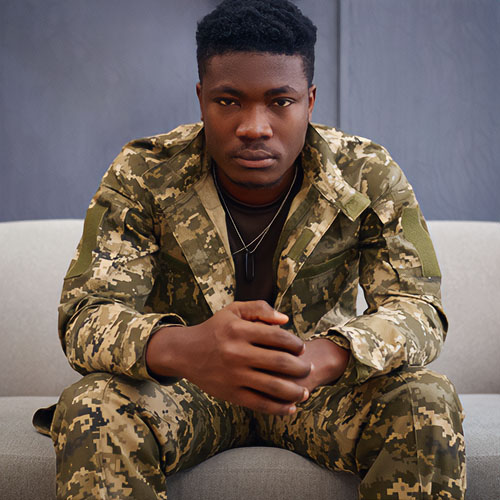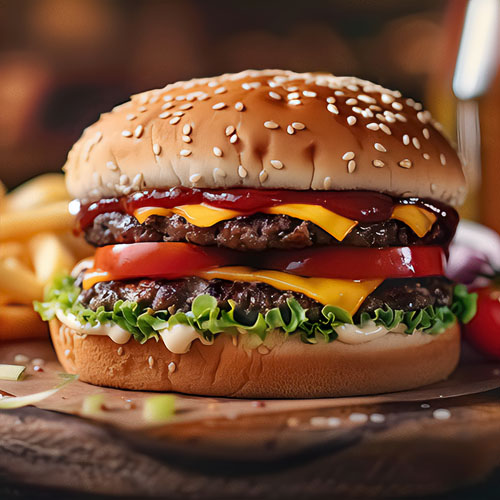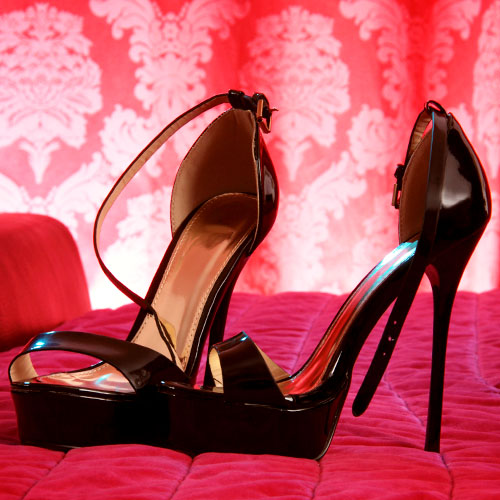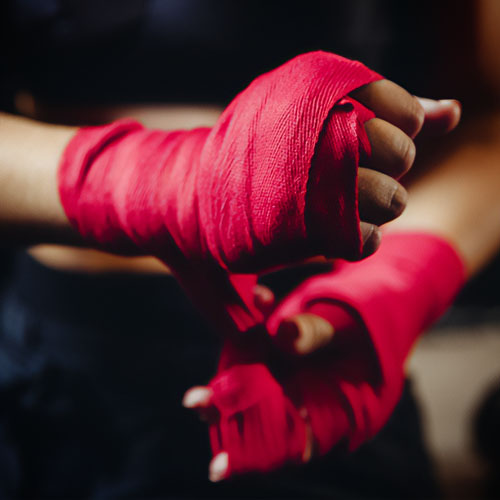Jesse James, twenty-first century, is not your granddaddy’s outlaw.
A Legend Reborn
The Jesse James of today has chopper posture: His back arcs over long legs that stretch below large tattooed arms, which extend into brawl-scarred fists. Whether sitting in his office chair, bending over a piece of sheet metal in his shop, or eating lunch, he’s built to ride. Though he and the infamous bandit share a name and a branch on a family tree — his great-great-grandfather was cousins with the James of the Old West — Jesse James ain’t robbing banks these days. He’s building motorcycles.
The headquarters of Jesse James’s West Coast Choppers is neatly spread out over 11,000 square feet in Long Beach, California. It’s as immaculate as a shop of its nature can be — not your typical grease-monkey pit. Every nook and cranny of the facility smacks of James’s personality. From the orange-stenciled WCC boxes packed with fenders to the black iron spiderweb gates to the velveteen painting of an impish Satan taking a shit that hangs over the john, this is James’s domain.
In the shop the air is thick with the rank perfume of gasoline and exhaust. There’s a thundering din of hammering machines punctuated by the spark and hiss of welding torches on metal. Bikes in various stages of production fill the workstations as the small, elite group of people who toil on them perform meticulous tasks on each.
James picks up a plastic spray bottle of kerosene/gasoline. “Chicks dig this shit,” he says of the concoction, hanging the bottle on the side of a monstrous red Yoder power hammer (circa 1920) he acquired recently. He dons ear mufflers and slides a thin piece of sheet metal into the machine’s grasp. It shudders violently to life, adding wildly to the racket. He begins to shape what will become one of his trademark original gas tanks. A full 100 hours of work will be required before the tank’s completion.
When James first started out, his designs were so outlandish that people didn’t accept them. But that has changed through the years. “Sometimes the guys in the shop still think I’m out of my mind,” he says, laughing. “They’ll see something I’ve done half-way, and they’re like, ‘Are you smoking crack?’ But I can see the whole picture while I’m doing it.”
Jesse James, at age 32, has. already earned a position among the top names in the realm of all things motorcycles. Creator of some of the most expensive bikes in the world, he’s quickly on the rise in the mainstream, cornering the market as the hippest bike maker to the stars. When I met with him he was building a bike for Keanu Reeves, but he has already sculpted an 11-footer for Los Angeles Lakers center Shaquille O’Neal, and others for model Tyson Beckford, Metallica front man James Hetfield, and pro wrestler Goldberg. The prices are high. No bike rolls out of James’s shop for less than $45,000, and the ceiling these days is about to teeter over the $125,000 mark.
“Jesse James isn’t robbing banks these days. He’s building some of the most expensive motorcycles in the world.”
However high the price tag for one of his creations, James insists his business is not all about the dough. “The major sense of accomplishment is watching the people’s reactions,” he says. “The money comes and goes, but the reaction is what stays with you. Sometimes a client will come in and be all poker-faced, thinking if they show much reaction and act like they like it too much, they’ll get charged more. But I want them to really express what they’re thinking.”
Still, if you’re an average Joe with a blue collar, you’re not exempt from this motorbike finery. In fact, it’s regular guys that James perhaps likes best, because he himself is only one hop away from the wrong side of the tracks.
You can bring James the Harley that took you 20 years to save for and tell him, “Make it better.” He’ll work his magic on it.
“Bikes put me on the map. I use that to promote products,” he says of his thriving parts business. “If a client can’t afford for me to build a bike, they can at least afford an exhaust system. I’m here to make money, but I’m also here to have fun. It’s good to do things for the right reasons. Doing it only for the money, things can go wrong. There should be pride, a sense of accomplishment.”
When he shines the brightest is when you tell him to build you a bike from the ground up. And that’s just what he’ll do. James will whip up a recipe of metal and soul that will change forever the way you look at and feel about motorcycles. While Harleys are hardly rare nowadays, one of James’s most spectacular models, an oddly svelte, seductively evil El Diablo, certainly is.
The process of creating one of his bikes is painstaking. From the start, James has to get to know the client: which colors he likes, what music he’s listening to, the first hot rod he owned. James digests personal information about each client as a first step; then measurements are taken. Much like the tailor of a fine suit, James measures from the armpit to the palm for bar height, then from the inseam to the center of the foot. The bike has to fit its owner, not just look pretty — and it has to perform.
“I recently drove 70 miles at 80 miles an hour — with no hands,” James says. “That was the best feeling, to know I’d built something that rides that well.”
There are a few standard parts on James’s bikes: a 140-horsepower S&S engine, a six-speed Baker transmission, and a belt drive line from Rivera. Everything else is made in the West Coast Choppers machine shop.
The bike motors come unassembled. James’s crew polishes them, fits them with pistons and cylinders. He will go through various wheel designs with the client. The steering geometry is determined, then the bike is built up to a rolling chassis. James and company work on the gas tank and exhaust system. The bike is taken apart; the steel is polished, and then sent out to be dipped in chrome. A paint job follows — another labor of love, with hand-drawn flames using paints that per gallon can cost up to $4,500, the most expensive paint in the world.
“Bikes in various stages of production fill the work-stations as the elite group of people who toil on them preform meticulous tasks.”
His one-of-a-kind motorcycles don’t just break your bankroll, they break your heart. His typical demographic — if there is one — ranges from young punks with chips on their shoulders to old-time bikers and hot-shit athletes and actors. A romp through his shop/showroom will rouse a raging erection in them all.
West Coast Choppers puts out 12 to 15 bikes a year, and James is back-ordered by more than a year. When a client places an order, he can expect at least a six-month wait. “Right now there are three bikes in here waiting for me to make gas tanks for them,” James says, seemingly unworried.
There was a humble start for the motorcycle maven. James is the first to tell you that he’s from a classic white-trash family stamped with the trademark dysfunction of American cuckoldry and divorce. His father, who was in the antique-furniture business, shared a warehouse during the 1970s with a company that was then the largest aftermarket manufacturer in the world for Harleys and sport bikes. Jesse still remembers those bikes.
“My dad was like the white Fred Sanford,” James says, “and I was Lamont.”
During freshman year of high school he was the only one in metal shop not making bongs. When class was over, he was still making bike parts. He made his first exhaust later that year in his mother’s garage. “I threw it away before anybody saw how bad it sucked.”
The legend, however nascent, was looming.
His salient independence emerged early. “I moved out of the house when I was 15,” he says. “My parents were fuckers. I knew I could do a better job myself.”
Something of a paradox, James was a jock — a nose guard on his high school football team — in spite of his troubles. For kicks (and to make ends meet), he was also a juvenile delinquent in his spare time. James admits he was always in trouble. “One day in algebra class during my sophomore year, I got taken out of class by armed police officers because I’d beaten the hell out of a guy at a 7-Eleven.”
Fortunately for James, something in him changed when he turned 18. “I woke up,” he says. “I was smart enough to figure out that as long as I was a minor, none of this shit would go on my record. I guess I figured I had a hall pass to fuck up during my youth.”
He attended the University of California at Riverside. At the time they had the No. 1 junior-college football record in the country. “The tuition was $175, and I remember counting quarters to get up that amount,” he says. “The whole jock thing … I loved hitting people hard. People didn’t understand.”
Shortly after enrolling at UC-Riverside, James blew out his knee playing football, then he scrapped college. A friend of his father’s put him through antiterrorist school, and he was tutored in combat gun tactics. There are a couple of hazy years here that he won’t talk about, but the gunshot wound in his left shoulder may be testament to those days.
Afterward he spent some time as a bodyguard for bands like Soundgarden, Danzig, Slayer, Nirvana, and Pearl Jam. He lived for several years in Europe, spending his free time going to motorcycle shops and shows. “I was doing market research for what I’m doing now,” he says.
“James’s one-of-a-kind motorcycles, built from the ground up, don’t just break your bankroll, they break your heart.”
Along the way, he married Carla. “The bodyguard job was getting old fast,” he says. “I wanted to do something I loved to do. My chick looked at me like I was crazy when I gave up a $100,000-a-year job.” He started working for Boyd Coddington, hot-rod builder extraordinaire. Absorbing everything he could about metalworking and reading up on metallurgy, James eventually decided to set up shop on his own.
With his wife at his side, he opened West Coast Choppers nearly seven years ago. No loan. No partners. Just blood, sweat, and tears. Every penny made was reinvested. Carla handled the money and Jesse worked, sometimes 15 hours a day. “If I don’t work between 12 and 15 hours a day,” James says, “I feel I’ m cheating myself. I didn’t get where I’m at just dreaming about it. It wasn’t magic.”
James is fresh off the road from Sturgis, having ridden the entire 1,800 miles on his bike. Standing in his showroom, plate-glass windows overlooking Oregon Street, he greets visitors who gaze at him in unabashed awe. “That’s him,” someone whispers. He shakes hands, they tell him he’s an artist. It’s becoming a bit of a tourist attraction.
Steve McQueen’s last bike sits near two pinball machines.
A tank is filled with mini sharks, which slash their tiny fins through illuminated water. Goldberg’s bike and Shaq’s, too, await pickup, glowing as if on fire.
Business is better than ever. Production of his bolt-on parts has always fed the financial needs of the company and often supported the heart of the firm’s true love: building bikes. His fenders are extremely popular in Europe, where he says he does ten times as much business. But since the Discovery Channel discovered him and ran the one-hour documentary Motorcycle Mania last year, James isn’t having to count quarters anymore. A sequel to that show is scheduled to air in January, and James has been pegged by Discovery to host an as-yet-untitled TV show.
“It’s good to see everyone working,” he says, surveying the buzz around him. “When I first started it was just me and a cleaning guy.”
‘“I challenge myself constantly,” says Jesse James. Every year his bikes get better. Each bike is like a fingerprint, and James revels in his growth as a craftsman.’
Still early in the game, with only about 50 bikes under his belt, James, an insomniac, has a long way to go before he sleeps. As a man, he’s wrestling the same beasts as any: His marriage of nine years to Carla ended recently, leaving two tow-headed kids in its wake.
The rest of his family remains fairly remote. “My dad lives in a trailer,” he says. “He doesn’t have a phone. If I want to wish him happy birthday, I have to call the liquor store and leave a message.”
But the essence of Jesse James is fertile and promising, unlimited. Every year his bikes get better. Each bike is like a fingerprint, and James revels in his growth as a craftsman; he knows that this is what will keep him climbing steadily to the top.
“All the notoriety makes me want to try harder,” he muses. “I want the bike to be even better than they thought it would be. I challenge myself constantly, try to keep educating myself. I become more skilled. In this industry there are a lot of copycats, just bottom-feeders. I’m trying to expand. I’m a risk taker. I’II bet the farm. Let’s go for it — that’s me. If I dropped dead right now, I think I could say I’d led a full life.”
Now should you desire to increase your in person Jesse James research, you may still do that at West Coast Choppers. We are not promising you will get to meet Jesse whenever you show up, but if you do, it will be a memorable experience. … Should you just love bikes, we have some other suggestions right in these digital pages.
























